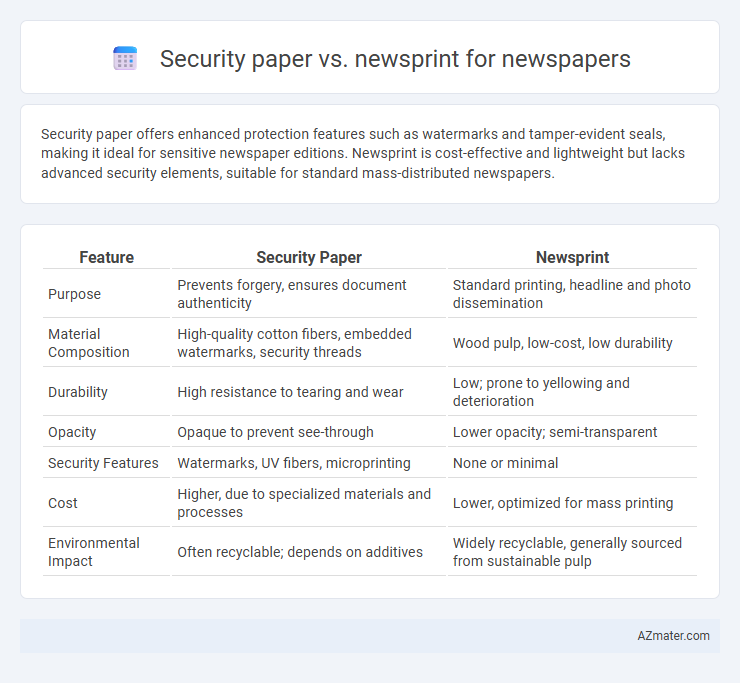Security paper offers enhanced protection features such as watermarks and tamper-evident seals, making it ideal for sensitive newspaper editions. Newsprint is cost-effective and lightweight but lacks advanced security elements, suitable for standard mass-distributed newspapers.
Table of Comparison
| Feature | Security Paper | Newsprint |
|---|---|---|
| Purpose | Prevents forgery, ensures document authenticity | Standard printing, headline and photo dissemination |
| Material Composition | High-quality cotton fibers, embedded watermarks, security threads | Wood pulp, low-cost, low durability |
| Durability | High resistance to tearing and wear | Low; prone to yellowing and deterioration |
| Opacity | Opaque to prevent see-through | Lower opacity; semi-transparent |
| Security Features | Watermarks, UV fibers, microprinting | None or minimal |
| Cost | Higher, due to specialized materials and processes | Lower, optimized for mass printing |
| Environmental Impact | Often recyclable; depends on additives | Widely recyclable, generally sourced from sustainable pulp |
Introduction to Newspaper Printing Materials
Security paper offers enhanced durability and tamper resistance crucial for safeguarding sensitive newspaper content, while newsprint remains the standard due to its cost-effectiveness and ease of use in high-speed printing presses. Newsprint is typically made from recycled wood fibers, providing a lightweight, absorbent surface optimal for ink absorption and quick drying, essential in mass newspaper production. Security paper incorporates watermarks, embedded fibers, and chemical treatments, ensuring authenticity and preventing counterfeiting, which is particularly important for special editions and official publications.
What is Security Paper?
Security paper is a specialized type of paper designed to prevent counterfeiting and unauthorized copying, commonly used in official documents and currency. It incorporates features such as watermarks, embedded fibers, and chemical sensitizers that reveal tampering attempts. Unlike regular newsprint, which is inexpensive and lacks security features, security paper ensures enhanced protection and authenticity for sensitive printed materials.
What is Newsprint Paper?
Newsprint paper is a low-cost, lightweight paper primarily made from wood pulp and used extensively in printing newspapers due to its high absorbency and quick drying properties. It features a slightly rough texture and lower brightness compared to security paper, making it ideal for mass production and daily distribution. While security paper incorporates special fibers or watermarks to prevent forgery, newsprint is optimized for fast, economical printing and large volume runs.
Key Differences: Security Paper vs Newsprint
Security paper incorporates embedded watermarks, security threads, and chemical treatments designed to prevent forgery and unauthorized reproduction, making it ideal for sensitive documents and currency. Newsprint is an inexpensive, low-quality paper made from wood pulp with high lignin content, resulting in a short lifespan and susceptibility to yellowing and deterioration, primarily used for mass-distributed newspapers. While security paper emphasizes durability and anti-counterfeiting features, newsprint prioritizes cost-effectiveness and ease of printing for daily information dissemination.
Durability Comparison
Security paper offers superior durability compared to newsprint due to its higher resistance to tearing, moisture, and fading, making it ideal for preserving important documents and longer-lasting publications. Newsprint, typically made from inexpensive, low-density wood pulp, tends to yellow and degrade quickly under exposure to light and environmental conditions. The enhanced fiber quality and treatment processes in security paper ensure better longevity and protection against physical and chemical deterioration.
Cost Implications for Publishers
Security paper typically incurs higher production costs than standard newsprint due to specialized materials and anti-counterfeiting features, impacting publishers' budget allocations. Newsprint remains more economical, favored for mass circulation despite its lower durability and vulnerability to forgery. Publishers must weigh cost-benefit factors, with security paper offering enhanced protection but imposing greater financial strain.
Printing Quality and Readability
Security paper offers superior printing quality with higher brightness and smoother surface, enhancing ink absorption and sharpness for clearer text and images compared to newsprint. Newsprint is more porous and absorbs ink unevenly, leading to lower print resolution and potential smudging, which can reduce readability. The durability and opacity of security paper also improve newspaper longevity and prevent show-through, contributing to a better reader experience.
Environmental Impact of Each Paper
Security paper for newspapers typically involves higher-grade fibers and chemical treatments that can increase environmental impact due to energy-intensive production and limited recyclability. Newsprint, made primarily from virgin wood pulp or recycled fiber, generally has a lower carbon footprint due to its simpler manufacturing process and higher recyclability rates, especially when sourced from sustainably managed forests. The environmental impact of each paper depends significantly on factors such as pulp source, bleaching processes, and end-of-life recycling or disposal methods.
Use Cases: When to Choose Security Paper
Security paper is ideal for newspapers requiring tamper-evident features, such as sensitive government publications or legal notices, where preventing forgery is crucial. Newsprint serves well for standard daily or mass-distributed newspapers due to its cost-effectiveness and lightweight qualities. Choose security paper when authenticity, durability, and fraud prevention outweigh printing costs and weight considerations.
Future Trends in Newspaper Paper Choices
Security paper for newspapers is gaining traction due to its enhanced durability and anti-counterfeiting features, meeting growing demands for authenticity in media distribution. Newsprint remains popular for its cost-efficiency and recyclability, but future trends indicate a shift toward hybrid materials that combine security and sustainability. Innovations like embedded digital watermarks and eco-friendly coatings are shaping the evolution of newspaper paper choices to balance protection with environmental responsibility.

Infographic: Security paper vs Newsprint for Newspaper
 azmater.com
azmater.com